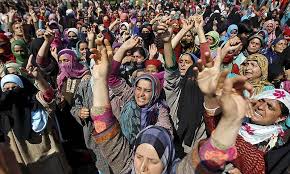Kashmir valley is wrapped with armed conflict from 1989 and after post-Burhan Wani, the turmoil changed completely. The valley had seen
After joining such groups, then day their picture with AK47 gets viral on social media. Parent’s appeal to return back, ADGIP request to shun violence, some return and some choose their own fate. However, all this is happening from past one year.
On the other side, military forces launch cordon and search operation in order to wipe out the militancy from the entire valley. In this operation, Hundreds of innocent civilians became the victim of military operations.
On national TV, they were labelled as stone pelters and supporters of terrorist and their killings are justified on the theory of everything is fair in love and war.
This year 2018 Shopian district of Jammu and Kashmir have largest number of civilian killings, which were directly killed by army. An FIR was also launched against army Major namely Aditya. However, his father had filed a PIL in Supreme Court that quashed the FIR and advised the state police not to include his name.
In such civilian killings, no one was either arrested nor did any investigation happen further. Within a month, another shootout occurred at outskirt a village namely Pinjoora (Shopian), where a militant was killed.
Later it was found that four youth also lost their lives in the shootout. All the four were labelled as over ground workers my Army and police, which was refuted by the locals.
First April 2018, created a new chapter in the history of valley. On that particular day, 19 killings happened in the three anti-militancy operations.
Out of 19, 13 were militants. Soldiers were 3 and 4 were civilians. Anger and despair was visible on the streets of Kashmir ahead of bloody Sunday in which huge number of local killings occurred in different encounters of the south Kashmir.
Besides that hundreds of people suffered pellets injuries and were admitted to various hospitals for treatment. Internet service were snapped, train service remained suspended, schools and colleges were closed, examinations and interviews were postponed and undeclared curfew was imposed in the neighbouring districts.
After the Shopianmayhem, another heart wrenching incident occurred in Laroo,Kulgam on 21st October.
On particular date, 09 civilians got killed and 45 were injured during a blast near the encounter site. The bloodbath in the valley traumatised the entire valley particularly. Protests, shutdowns were observed day after day.
The Valley is losing not only its populace, but are facing economic crisis as well.
According to the Articles of 48 and 51 of the first protocol of the Geneva Convention, which not only prohibits the killing of combatants on either side, but also prohibits direct attack on civilians.
India, the “democratic” country is also a signatory of the convention, but till yet did not ratified these laws. Besides that article 8(2) B and E of the Roman Statute of the international criminal court also prohibits intentionally killing of any civilian.
Jeff McMahan states in “the Ethics of Killing in War” that there is no moral justification for any intentionally civilian killing.
Comparing the Kashmir valley, here state of emergency is from both sides. The direct attack on civilians are justified with null theories.
The report that Jammu and Kashmir Police is submitting to the State Human Rights Commission is based on lies and blames.
The killings by the state is to create fear and panic in a population by murdering a large number of civilians. The killing is done intentionally, because the propagator believes that they are protected both by laws of armed conflict as well as ordinary laws concerning homicide.
It is notable that those who formulated the impunity laws are soaking their hands with the blood of innocent Kashmiri people and those who are justifying the killings understand that there humanity is dead. The killing of one innocent person is the death of whole humanity.
Inam ul Haq
Author is a research scholar at Central University of Gujarat
mantooinam72@gmail.com





